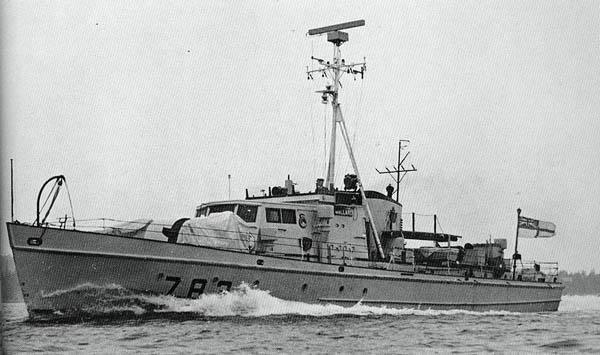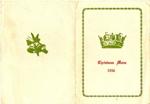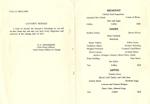780 CGLO HMCS LOON
“Bellamy Q”
781 CGTN HMCS CORMORANT
“Calamity Q”
782 CGZH HMCS BLUE HERON
“Debutante E”
783 CZCU HMCS MALLARD
“Ellsworth Q”
NOT BUILT
784 CZFP HMCS ARCTIC TERN
“Oberlin P”
785 CZGV HMCS SANDPIPER
“Retention P”
786 CGYH HMCS HERRING GULL
“Suspender Z”
787 CGKK HMCS KINGFISHER
“Terminology B”
|
|
|
| Length: 92 feet | Beam: 17 feet |
| Draught: 5 feet 4 inches | Displacement: 66 tons fully loaded |
| Top Speed: 14 knots; Two diesels. 300 hp. each with variable-pitch propellers. | Crew: 2 officers and 19 men. [5] |
| Armament: 1 Oerlikon gun, depth charges, 20 mm hedgehog [3] | Displacement: 66 tons |
The first of these, HMCS LOON was commissioned in 1955 and the other three joined the fleet in 1956. For unknown reasons, the navy went to the trouble of assigning pendants, names, call signs and voice call signs but did not build the last four (784 to 787) boats.
In an unusual move, the RCMP had a sister Bird Class boat built with steel instead of wood. Named RCMP Victoria, call sign CGMS, the boat was based on the west coast. In all probability, it was the only Canadian steel-hulled vessel which was built from wooden boat plans.
The "Birds" were the only known RCN vessels whose crews enjoyed the daily tot of rum without an officer present to make sure the keys to the rum locker didn't go astray. As a result, each vessel was chronically short of the product. To ensure that consumption matched remaining stock, there was late-night swapping of rum stores between Loon, Mallard and Cormorant whenever the auditors from the Navy visited the ships.
Bill Giroux who served in the Loon, confirms balancing the Rum Locker prior to inspection. "I was the Cox'n in Loon and have had to do just that. In my case the Auditors were heading up the Jetty and I had just time enough to jump from Loon's Foc'sle to Cormorant's, pick up the required amount of "Nelsons Blood" and get back to greet the Auditors as they were ushered into the forward Mess where the Rum Lockers were situated. Not only that, but on a couple of occasions Lt. Swan (Supply Officer Dockyard) was very suspicious of the request for writing off a few forty's of rum due to firing our Hedgehogs. I'm so proud of those days."
Hart Watt, ABWU1 who served on the Loon 1962-3, adds to this. "I never had any sharing of rum with the other "Birds" but on the Loon we were attached to Scotian and were always vittled with extra personnel, even when there weren't any. Chief Lovekin, the captain on the Loon always seemed to have some extra to give to his guests. He did give an extra ration once when we were coming from Point Edward Naval Station in Cape Breton to Halifax and it was extremely rough. The radar broke off the mast on that trip. We tied up at the supply depot at the bottom of Water Street in Halifax, where the casino is now. The RCMP boat Wood tied up on the other side of the jetty. If we ran out of something (when we were having a few wets) we could always count on the Wood to have a little extra".
These vessels were usually found patrolling around the inshore waters of the East Coast. Another common task was to sail into the Great Lakes and provide Navy reserve personnel some hands-on training in seamanship. When the last three were paid off they went into temporary reserve at Shearwater, NS.
INDIVIDUAL VESSEL HISTORIES
HMCS LOON 780
Commissioned: Nov 30, 1955
Builder: Taylor Boat Works. Toronto, Ontario
Paid off: Aug 30, 1965
Commanding Officer: C1BN Trevor Lovekin (1962)
While navigating the approaches to Halifax harbour in January 1962,
the SS SUERTE became disoriented and ran hard aground on Shut-In Island.
LOON was the first on the scene but could do nothing because of the high
seas. One Air Force and two Navy helicopters lifted the twenty-eight crew
members to safety. Then LOON was assigned the task of monitoring the wreck
until it was declared a total loss and was towed off the rocks and sunk
on April 6th, 1962. The SS SUERTE started out in 1944 as the British Samlistar,
call sign GWDK. They were ships built by the U.S. and sent to Britain under
Lend-Lease. There were many "Sam this" and "Sam that" therefore they
became known as Sam Boats. SUERTE was registered in Lebanon with
call sign ODEZ when wrecked in 1962.
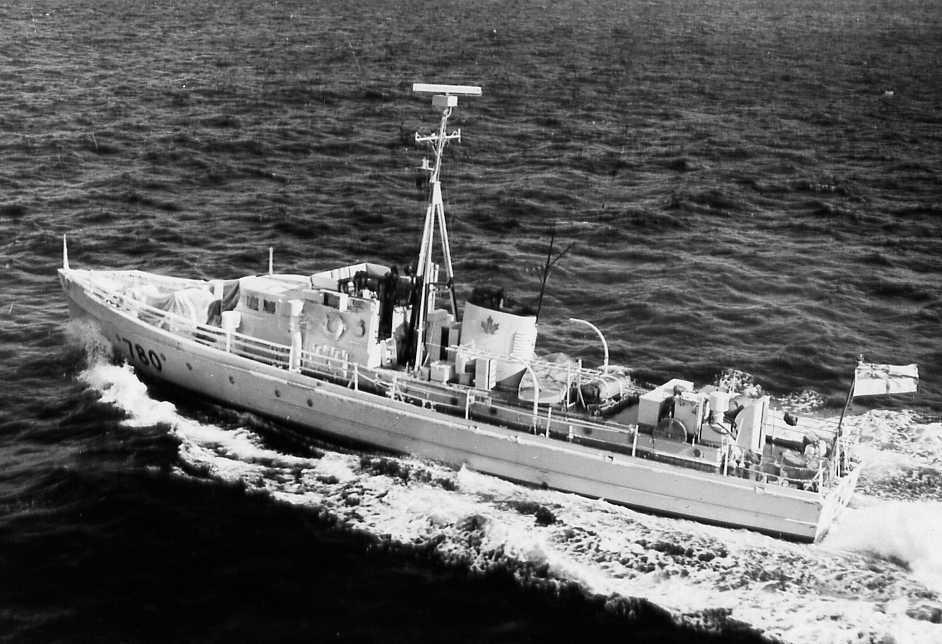 |
| HMCS LOON as seen on February 29, 1962. Note the thin coating of ice on the forward portion of the boat. (DND photo DNS28550) |
After service with the navy, the late Winston Lyons of Halifax bought the LOON and lived in her for a few years with his family [4] alongside the Government Wharf at Sambro, Nova Scotia. He was a seaman in the Coast Guard Lifeboat 117 at the time. While living aboard, Winston stripped LOON of many components including the main engines and sold them separately. Eventually he sold LOON but the boat's whereabouts is not known at this time.
HMCS CORMORANT 781
Commissioned: July 16/56
Builder: Birdland Boat Works. Midland, Ontario
Paid off: May 23, 1963
Commanding Officers: C1BN Ted Rigby (1960)
C1BN Henderson (1962)
In 1960 there were branch shake-ups within the navy and personnel were not given any notice. Tom Fullerton, who served in this boat in the Spring/Summer of 1960, expands on this. "Without warning, I became ABSN1 (Sonarman) on Jan 1, 1960, yet I was still working as a junior electrician (ABLM1) aboard HURON. When I asked what I was supposed to do, the answer from the Chief Electrician was to just carry on working in the electrical department until someone could figure out what was going on. I did so until I left HURON in May 1960 after being drafted to CORMORANT.
Once aboard CORMORANT I suddenly realized what a huge mistake the drafting depot had made. The depot had assumed that because I was a Sonarman, I had been "brought up" as a TD rating, a trade that included all aspects of seamanship. In fact I wasn't familiar with seamanship at all. I had been trained only as an electrician. Electricians, like stokers and radiomen and other trades, lived in their own little world and did not practice seamanship except as it applied to maintaining their own spaces.
One day, as we were about to berth at the jetty after a day at sea, the chief of the boat had yelled a command at me from the bridge and I hadn't a clue what I was supposed to do. Then, in jest, he told one of the rates (who is now an old pal of mine) to "go aft and give that big dummy (me) a boot in the arse.
A week or two later the Chief had me down to his cabin, and very gently explained to me that I wasn't really suited to work on the boat, and that he had spoken with a chum of his at the manning depot to get me a berth aboard HAIDA. I was in total agreement, and not unhappy with the result. Aboard HAIDA I got a bit of shore training on sonar sets (mainly 164), but was soon posted into Stadacona for a Trade Group 2 sonar course. I spent the rest of my active sea-going career (4 years) aboard RESTIGOUCHE, then to the Reserve Squadron for the remainder of my 10-year service".
The story about Cormorant's accidental firing of her Hedgehog is almost legendary and is outlined in this account by the author who wished to remain anonymous in 1960.
"HMCS CORMORANT and the Hedgehog," by Anonymous. (c. 1960)
What I am about to relate to you is true! You may not believe it but it happened one morning around 11:00 Jetty 0 (zero) at HMC Dockyard, Halifax.
Don Pearson, a weapons technician, would periodically test the circuits for the Hedgehogs we had up near the bow. ( 8 hogs I believe). This particular morning while in the wheelhouse with the Buffer and two other ratings, we heard a whooosh and felt the boat give a shudder. Pearson had inadvertently shot off a hedgehog straight up into the air over the railroad tracks and it disappeared behind the houses on Barrington Street. We all waited to hear an explosion which never came. Can you believe when I say we were all dumbstruck!
Up came white faced Pearson through the small hatch stuttering and shivering from fright. We were out by the hedgehog rack by now and nobody said a word, except Pearson. "I guess I had better go get it." The buffer was pusser [strict] and wanted to report it, but we talked him out of it. "Lets wait until we see where the land lays." Reluctantly he agreed but said he would take a walk in the dockyard so he wouldn't be involved seeing he was senior man onboard. Pearson took off up the jetty. Somehow or another there was no one high in rank left onboard except a hooky bos'n.
It was almost 45 minutes later when Pearson waltzed nonchalantly down the jetty carrying the hog on his shoulder. He said it left a hole in the road outside of The Seagull Tavern on Barrington Street on the harbor side. Cars just drove around it Pearson said. He picked it up and headed back to the dockyard and to all our surprise no one said a thing at the gate. They just waved him through carrying the hog! This is true! So there you have it, a military secret!
HMCS BLUE HERRON 782
Commissioned: July 30, 1956
Builder: Hunter Boat Works. Orillia, Ontario.
Paid off: Nov 19, 1956
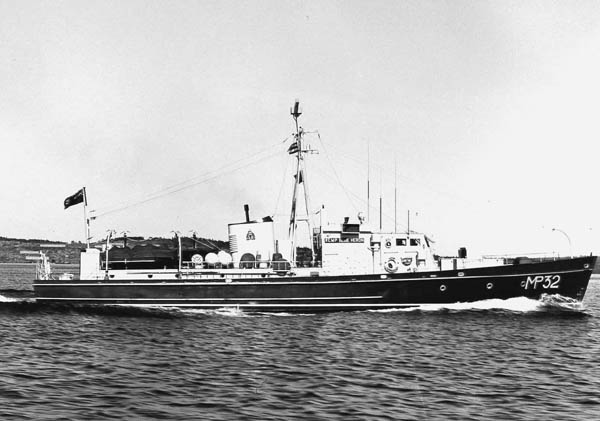 |
| Blue Heron in RCMP service as MP32. In 1959, just before the opening of the St. Lawrence Seaway, the RCMP fleet went to a blue hull, yellow pendant, white superstructure and light grey funnel. (Royal Canadian Mounted Police photograph submitted by Spud Roscoe VE1BC.) |
Commissioned at Orillia Ontario, she sailed to Halifax. In November 1956 she was paid off then transferred to the Marine Division of the Royal Canadian Mounted Police. BLUE HERON became RCMP BLUE HERON MP32, call sign CGZH, the only former naval vessel to join the RCMP fleet and retain her naval name and call sign". The boat served with the RCMP from 1956 to1968.
Blue Heron was called a Fort Class RCMP vessel because she was similar in size to her sisters named after the RCMP Forts. This fleet had communications gear second to none. Blue Heron carried a federally certified radio operator; a graduate of one of several Canadian radio schools. She was fitted with a Canadian Marconi CM11 transmitter/receiver and a Canadian Marconi CN86 radiotelephone as her main radio gear. Her Motorola RCMP radio equipment had been recently upgraded from the 49 MHz band to the 155 MHz band. She was capable of communicating with everything; the commercial coast stations, the coast guard and naval ships and stations of any nation, the merchant ships of any nation and many RCMP stations using Morse Code. A ship of any nationality could contact her or one of her sisters simply by calling CGMP on 500 KHz.
Since Blue Heron was based in Halifax, she mainly communicated with CW station XJA88 also located in Halifax but also kept in contact with CFH, VCS, VCO, VAU and the local coastal stations. When at sea, Heron indicated her current position to XJA88 at 08:00 and 16:00 daily on any one of three available frequencies. Each Division and Sub-Division had a CW station run by civilian members of the RCMP. All RCMP radio stations had a three letter two digit call sign with the XJ prefix. The operations room of XJA88 contained CSR5 receivers and was located in 'H' Division Headquarters. The transmitter was built by Wilcox Electric in Kansas City U.S.A. and was located at Hartlen Point. 'H' Division is the province of Nova Scotia and Sydney is a Sub-Division. The RCMP still uses their three HF frequencies in upper sideband, especially in the isolated regions of Canada. The lowest frequency used is 4 MHz and the highest is on 14 MHz.
HMCS MALLARD 783
Commissioned: July 16, 1956
Builder: Grew Boat Works. Penetanguishene, Ontario
Paid Off: Sept 2, 1965
